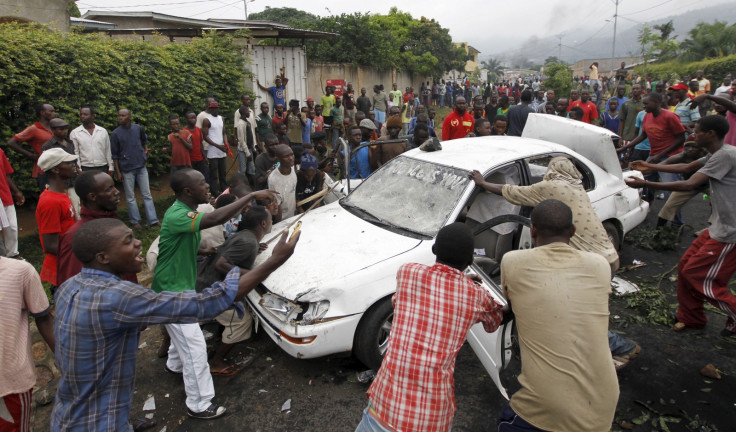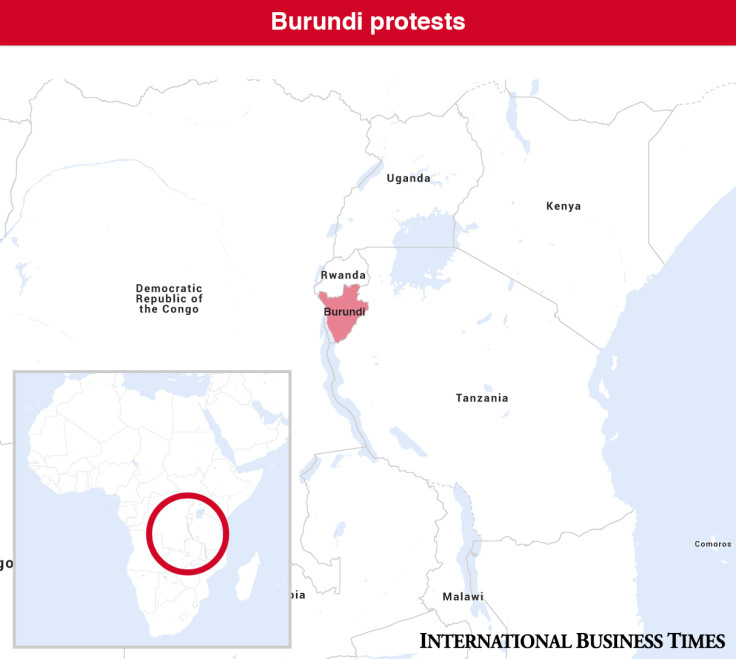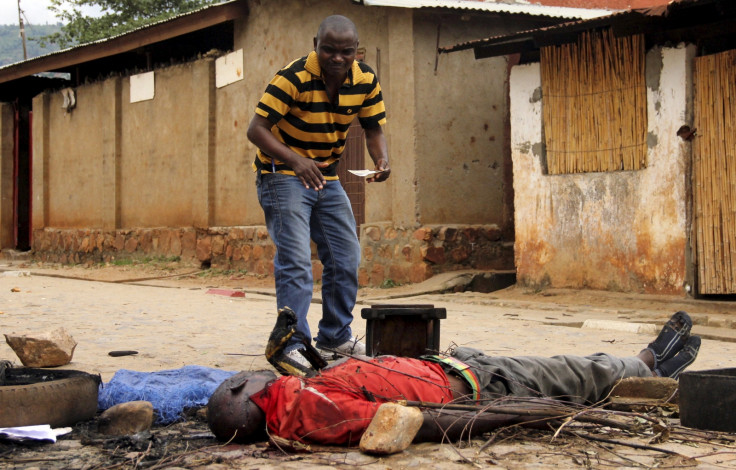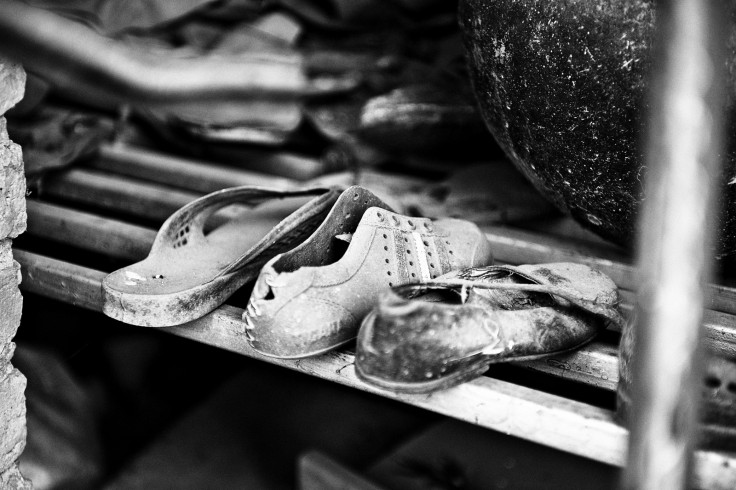Burundi violence: From Belgian colonisation to ongoing fight for democracy

At least 20 people have been killed in Burundi after violence erupted at the end of April following President Pierre Nkurunziza's announcement that he will seek a third term in the June election.
Protesters accused the leader of violating the constitution and the Arusha Peace Agreement, which says the president can only stay in power for two terms.
The agreement was signed in 2000 and intended to pave the way for democracy and end the civil war fought between Hutu and Tutsi, which has killed some 300,000 people since 1993. However, Nkurunziza's supporters argue the president's first term should not be counted as he was chosen by the parliament and not by people as indicated in the document.
While violence is escalating in the country and at least 40,000 people, mainly Tutsi, have fled fearing a genocide could occur against them. IBTimes UK looks at Burundi's recent history from the colonisation era until recent unrest.
Colonisation
Burundi became, together with Rwanda, a German colony in 19<sup>th century.
The country, part of the German East Africa, remained under the German rule until the end of the Second World War, when Belgium took control of the so-called "Rwanda-Urundi", modern day Rwanda and Burundi, that became a Belgian League of Nations mandate.
As it happened in Rwanda, the Belgians initially supported the Tutsi ruling class in Burundi over the Hutu majority population. The interference sparked ethnic tensions among the two groups.
According to Uganda-based independent journalist Fulvio Beltrami, who reports on countries that form Africa's great lakes region, during the pre-colonisation era Hutu e Tutsi were not considered two different ethnic groups.

"They spoke the same language, shared same religions, culture and habits. They were two social classes: the farmers [Hutu] considered inferiors, and the cattle herders [Tutsi] , considered superiors," Beltrami told IBTimes UK. "The power in the country was based on a very complicated social equilibrium. For example, the king and his descendants were Tutsi, but the king was obliged to marry at least one Hutu among the five wives he could have.
"The Belgians upset this equilibrium. They first supported Tutsi and then, when they realised that the Tutsi had nationalistic and communist values, started supporting the Hutu and claimed that the Tutsi had come from Egypt and had exterminated and subjugated Hutu people in Rwanda and Burundi. From this hate stemmed the so called 'Bahutu manifesto' that was the ideological basis of the Rwanda genocide."
Independence and massacres
The League of Nations was dissolved in 1945 and became a UN trusted territory, still under the control of Belgium. Burundi gained independence and established a constitutional monarchy in 1962. The then leader Mwami Mwambutsa IV became the king.
Hutu and Tutsi were both represented in the parliament but political and ethnic tensions continued to run among the two groups.
The tensions culminated in an attempted coup d'etat by the Hutu-majority police in 1965, when Mwambutsa elected a Tutsi prime minister, sparking dissent among Hutu, who argued they were holding the majority of seats in parliament. The coup, as well as following riots, were violently suppressed by the army.
Burundi became a republic in 1966, when Tutsi prime minister Michel Micombero deposed Mwambutsa's son Prince Ntare V and established a military regime.
In 1972, the all-Hutu organisation known as Umugambwe w'Abakozi b'Uburundi or Burundi Workers' Party (UBU) systematically attacked Tutsi in the country. The army responded with attacks that targeted the Hutu population. It is estimated that between 150,000 and 300,000 people, mainly of Hutu origins, were killed, while hundreds of thousands fled the country.
According to a report by French-American political analyst René Lemarchand: "The steady rise of Hutu-Tutsi enmities, accompanied by the more or less systematic exclusion of Hutu from the institutions of government, must be seen as a central element in the background of the 1972 killings."
In the following years, Hutu who had belonged to UBU disseminated anti-Tutsi propaganda leading to further massacres in 1988.
In 1987, Pierre Buyoya became the new president following a coup that overthrew former leader Colonel Jean-Baptiste Bagaza. A year later, thousands of Hutu were massacred and other fled the country. Buyoya was in power until 1993. He became president again in 1996 following another military coup.
Civil war
Beltrami expained that following the assassination by Tutsi army extremists of the then president Melchior Ndadaye in 1993, current president Nkurunziza's party, National Council for the Defense of Democracy (CNDD-FDD), allegedly tried to carry out a genocide against the Tutsi minority in the country.
In retaliation, the army, mainly composed of Tutsi, massacred thousands of Hutu and whoever was suspected of being a CNDD-FDD supporter. The murders triggered the country's civil war.
When Ndadaye's successor Cyprien Ntaryamira was killed together with Rwanda's president Juvénal Habyarimana – assassination that sparked the 1994 Rwanda genocide – the Burundi's conflict aggravated. In the decade of civil war that followed, an estimated 300,000 people, both Hutu and Tutsi, were massacred.
The warring factions reached a peace accord in 2000 in Arusha, northern Tanzania, signing the Arusha Peace Agreement, which called for an end of violence and democratic elections.

Ongoing violence
Beltrami explained that the ongoing unrest in Burundi stems from what he called "inappropriate peace agreements. Peace mediators UN, US, France and the Vatican refused the proposal of former president Buyoya of a gradual transformation of the political power.
"The Arusha agreement asked for a free election in a country that was not used to democracy. The result was that during 2005 election, people – both Hutu and Tutsi – voted according to ethnic preferences," he explained. "Justice was sacrificed in order to reach a compromise as none of those responsible for the previous massacres were brought to justice. Buyoya was granted impunity while Nkurunziza became president.
If a civil war erupts, it will be between conservatives forces that belong to the past and democratic forces that demand a multi-ethnic society
"The Arusha agreement saw the alternation of Hutu and Tursi powers, an alternation that has not been respected by Nkurunziza and that is deleterious because is based on the juxtaposition of two groups that historically were two social classes of a same ethnicity."
Beltrami also said the protest is political and this is shown by the fact that demonstrators are both Tutsi "and also Hutu who feel betrayed by their party".
He said: "I can confirm that some 40,000 Burundians have fled to Rwanda, Congo and Tanzania, but people who fled are both Hutu and Tutsi who fear their president as well as foreign militiamen. If a civil war erupts, it will be between conservatives forces that belong to the past and democratic forces that demand a multi-ethnic society and well-being as it is happening in Rwanda, Uganda, Tanzania and Kenya."
According to Beltrami, the Burundian population has been refusing peace accords suggested by the Catholic Church and is demanding freedom. He also urged the international community to support democratic forces in the country and "clarify with unmistakable acts that dictators have no place in Africa and around the globe".
Meanwhile, a separate report by IBTimes UK revealed the UN's Security Council received a file containing the details of the alleged assassinations of 22 figures of the Burundian opposition.
Burundi's civil society lawyer, Belgian lawyer Bernard Maingain, said a file – which he managed to sneak out of Burundi – included allegations about a secret service plot to kill those against Nkurunziza's contested third term.

Tensions between Hutu and Tutsi – a comparison with Rwanda
Beltrami believes that unlike their Rwandan neighbours, Burundians have overcome ethnic tensions over the years. He said: "If we take into consideration previous massacres, we cannot find premeditated genocide plans against both groups. These plans were present in the Juvenal Habirimana's regime in Rwanda and led to the 1994 tragedy that we all know.
"I can affirm that hate in Burundi has been always instigated by people in power, Hutu or Tutsi, but it has not been interiorised by the population. Nkurunziza himself is using the genocide threat as a political weapon, but I believe that should he become president for the third time, he would not carry out massacres due to regional factors as well as Burundian social and cultural carachteristics."
Beltrami also explained that in order to implement a genocide fear, Nkurunziza used the Imbonerakure, the youth wing of the CNDD-FDD, which, he alleged, has been brainwashed with genocide propaganda during training in eastern Congo by Rwandan terrorists from the Hutu rebel group Democratic Forces for the Liberation of Rwanda (FDLR).
He added that anti-Tutsi propaganda in Burundi has been slowly abandoned over the years, but this process has been halted by Nkurunziza as "ethnic hate is the only weapon he has left to stay in power. But should a genocide [against the Tutsi] occur in Burundi, I am confident that the Hutu population will stop it".

© Copyright IBTimes 2025. All rights reserved.




















